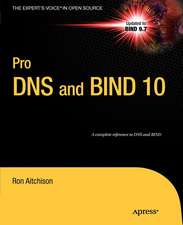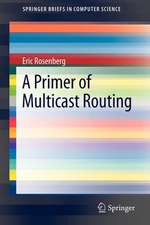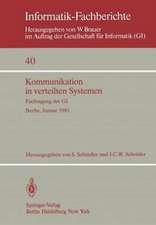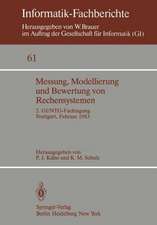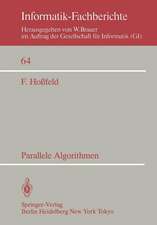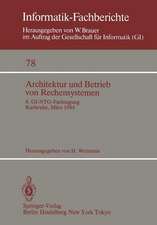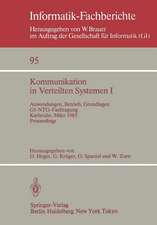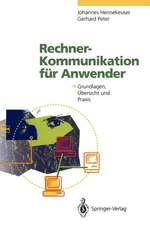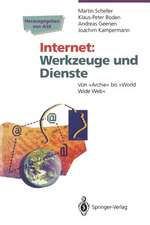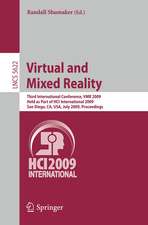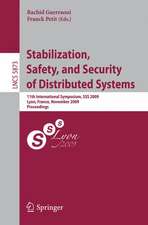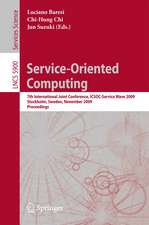Fractal Dimensions of Networks
Autor Eric Rosenbergen Limba Engleză Paperback – 8 iul 2021
The goal of the book is to provide a unified treatment of fractal dimensions of sets and networks. Since almost all of the major concepts in fractal dimensions originated in the study of sets, the book achieves this goal by first clearly presenting, with an abundance of examples and illustrations, the theory and algorithms for sets, and then showing how the theory and algorithms have been applied to networks. Thus, the book presents the classical theory and algorithms for the box counting dimension for sets, and then presents the box counting dimension for networks. All the major fractal dimensions are studied, e.g., the correlation dimension, the information dimension, the Hausdorff dimension, the multifractal spectrum, as well as many lesser known dimensions. Algorithm descriptions are accompanied by worked examples, many applications of the methods are presented, and many exercises, ranging in difficulty from easy to research level, are included.
| Toate formatele și edițiile | Preț | Express |
|---|---|---|
| Paperback (1) | 446.64 lei 43-57 zile | |
| Springer International Publishing – 8 iul 2021 | 446.64 lei 43-57 zile | |
| Hardback (1) | 596.93 lei 38-44 zile | |
| Springer International Publishing – 8 iul 2020 | 596.93 lei 38-44 zile |
Preț: 446.64 lei
Preț vechi: 558.30 lei
-20% Nou
Puncte Express: 670
Preț estimativ în valută:
85.47€ • 88.73$ • 71.27£
85.47€ • 88.73$ • 71.27£
Carte tipărită la comandă
Livrare economică 24 martie-07 aprilie
Preluare comenzi: 021 569.72.76
Specificații
ISBN-13: 9783030431716
ISBN-10: 3030431711
Pagini: 524
Ilustrații: XX, 524 p. 224 illus., 147 illus. in color.
Dimensiuni: 210 x 279 x 33 mm
Greutate: 1.21 kg
Ediția:1st ed. 2020
Editura: Springer International Publishing
Colecția Springer
Locul publicării:Cham, Switzerland
ISBN-10: 3030431711
Pagini: 524
Ilustrații: XX, 524 p. 224 illus., 147 illus. in color.
Dimensiuni: 210 x 279 x 33 mm
Greutate: 1.21 kg
Ediția:1st ed. 2020
Editura: Springer International Publishing
Colecția Springer
Locul publicării:Cham, Switzerland
Cuprins
1. Introduction.- 2. Networks: Introductory Material.- 3. Fractals: Introductory Material.- 4. Topological and Box Counting Dimensions.- 5. Hausdorff, Similarity, and Packing Dimensions.- 6. Computing the Box Counting Dimension.- 7. Network Box Counting Dimension.- 8. Network Box Counting Heuristics.- 9. Correlation Dimension.- 10. Computing the Correlation Dimension.- 11. Network Correlation Dimension.- 12. Dimensions of Infinite Networks.- 13. Similarity Dimension of Infinite Networks.- 14. Information Dimension.- 15. Network Information Dimension.- 16. Generalized Dimensions and Multifractals.- 17. Multifractal Networks.- 18. Generalized Hausdorff Dimensions of Networks.- 19. Lacunarity.- 20. Other Dimensions.- 21. Coarse Graining and Renormalization.- 22. Other Network Dimensions.- 23. Supplemental Material.-
Notă biografică
Eric Rosenberg has taught undergraduate and graduate courses in modelling and optimization at Princeton University, New Jersey Institute of Technology, and Rutgers University. He recently retired from AT&T Labs in Middletown, New Jersey, and has joined the faculty of Georgian Court University in Lakewood, New Jersey.
He received a B.A. in Mathematics from Oberlin College and a Ph.D. in Operations Research from Stanford University, and has authored or co-authored 19 patents and has published in the areas of convex analysis and nonlinearly constrained optimization, computer aided design of integrated circuits and printed wire boards, telecommunications network design and routing, and fractal dimensions of networks.
Dr. Rosenberg is the author of A Primer of Multicast Routing, and A Survey of Fractal Dimensionsof Networks, both published by Springer.
New research and applications relating to fractal dimensions of networks can be sent to Dr. Rosenberg at FractalDimensionsOfNetworks@gmail.com.
He received a B.A. in Mathematics from Oberlin College and a Ph.D. in Operations Research from Stanford University, and has authored or co-authored 19 patents and has published in the areas of convex analysis and nonlinearly constrained optimization, computer aided design of integrated circuits and printed wire boards, telecommunications network design and routing, and fractal dimensions of networks.
Dr. Rosenberg is the author of A Primer of Multicast Routing, and A Survey of Fractal Dimensionsof Networks, both published by Springer.
New research and applications relating to fractal dimensions of networks can be sent to Dr. Rosenberg at FractalDimensionsOfNetworks@gmail.com.
Textul de pe ultima copertă
Current interest in fractal dimensions of networks is the result of more than a century of previous research on dimensions. Fractal Dimensions of Networks ties the theory and methods for computing fractal dimensions of networks to the classical theory of dimensions of geometric objects.
The goal of the book is to provide a unified treatment of fractal dimensions of sets and networks. Since almost all of the major concepts in fractal dimensions originated in the study of sets, the book achieves this goal by first clearly presenting, with an abundance of examples and illustrations, the theory and algorithms for sets, and then showing how the theory and algorithms have been applied to networks. For example, the book presents the classical theory and algorithms for the box counting dimension for sets, and then presents the box counting dimension for networks. All the major fractal dimensions are studied, e.g., the correlation dimension, the information dimension, the Hausdorff dimension, the multifractal spectrum, as well as many lesser known dimensions. Algorithm descriptions are accompanied by worked examples, with many applications of the methods presented.
· Presentation of a unified view of fractal dimensions and the relationship between computing these dimensions for geometric objects and computing them for networks
· A historical view of the different dimensions, starting with Euclid, presented in a form that is not overly mathematical
· Many applications of the methods are discussed in a broad range of fields: art, biology, cosmology, food processing, marine science, neurology, etc.
· Many examples are provided to illustrate the computational methods
· Includes exercises throughout, ranging in difficulty from simple to research level
Caracteristici
Presentation of a unified view of fractal dimensions and the relationship between computing these dimensions for geometric objects and computing them for networks A historical view of the different dimensions, starting with Euclid, presented in a form that is not overly mathematical Many applications of the methods are discussed in a broad range of fields; from art to biology, cosmology to food processing, to marine science, neurology, etc. Many examples are provided to illustrate the computational methods Includes exercises throughout, ranging in difficulty from simple to research level

